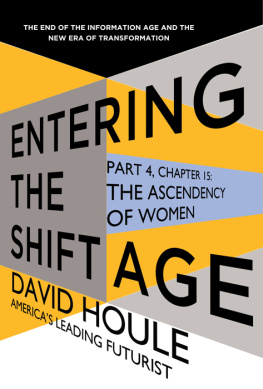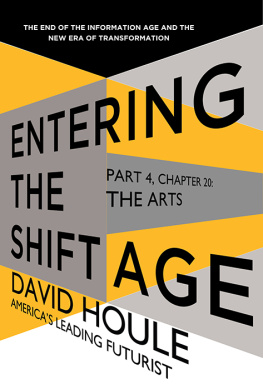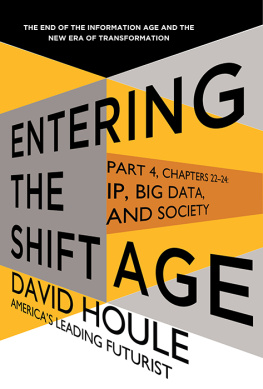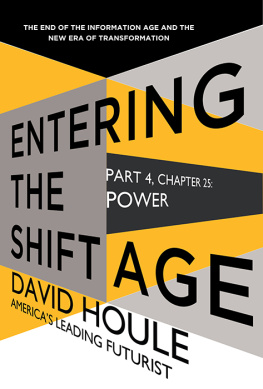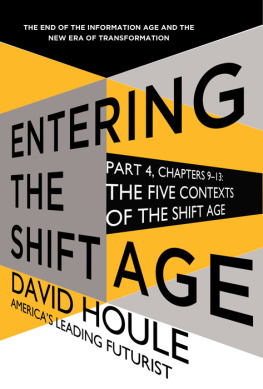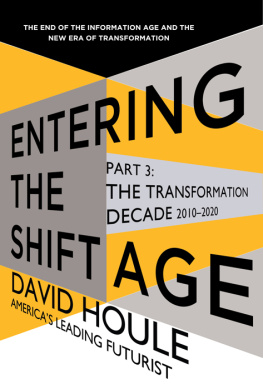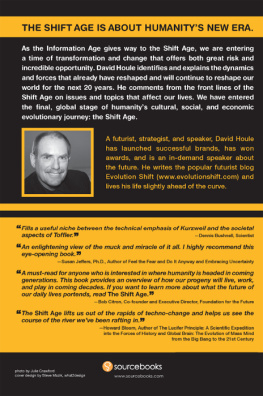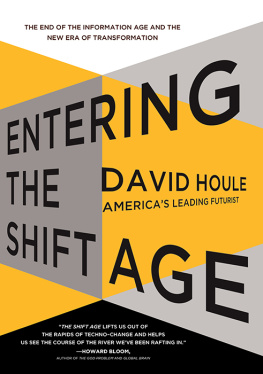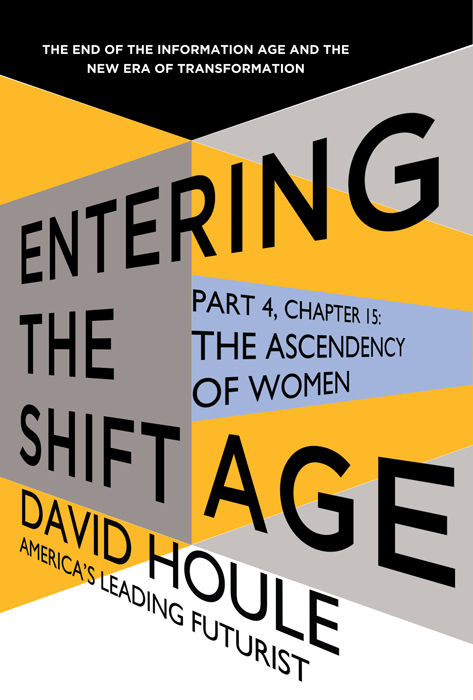
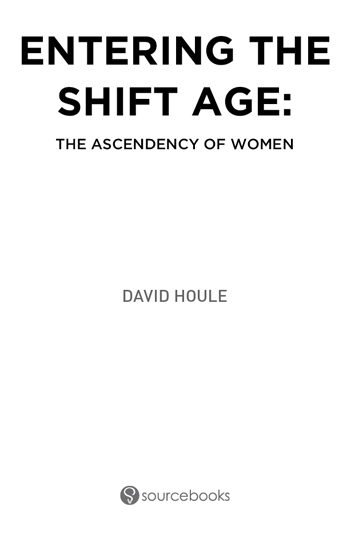
Copyright 2012 by David Houle
Cover and internal design 2012 by Sourcebooks, Inc.
Cover design by Studio Gearbox
Sourcebooks and the colophon are registered trademarks of Sourcebooks, Inc.
All rights reserved. No part of this book may be reproduced in any form or by any electronic or mechanical means including information storage and retrieval systemsexcept in the case of brief quotations embodied in critical articles or reviewswithout permission in writing from its publisher, Sourcebooks, Inc.
This publication is designed to provide accurate and authoritative information in regard to the subject matter covered. It is sold with the understanding that the publisher is not engaged in rendering legal, accounting, or other professional service. If legal advice or other expert assistance is required, the services of a competent professional person should be sought. From a Declaration of Principles Jointly Adopted by a Committee of the American Bar Association and a Committee of Publishers and Associations
All brand names and product names used in this book are trademarks, registered trademarks, or trade names of their respective holders. Sourcebooks, Inc., is not associated with any product or vendor in this book.
Published by Sourcebooks, Inc.
P.O. Box 4410, Naperville, Illinois 60567-4410
(630) 961-3900
Fax: (630) 961-2168
www.sourcebooks.com
CONTENTS
PART 4
THE FUTURE
OF HUMANITY
In Part Four, we will look at the future by first focusing on some large concepts and contexts of the Shift Age, followed by a close look at particular segments of society and humanity.
In Part Two, we looked at the three dominant forces of the Shift Age: the Flow to Global, the Flow to the Individual, and Accelerating Electronic Connectedness. These three forces are driving several big ideas that are initiating massive change now, and will have largely reshaped our world by the year 2025.
One clear difference between the Information Age and the Shift Age is content and context. The true clich of the Information Age was content is king. The reality of the Shift Age is context is king. Entering the Shift Age, we live in an increasingly contextual world. I have selected the five contexts I think have the greatest impact and influence.
THE FIVE MAJOR UNDERLYING CONTEXTS OF THE SHIFT AGE
1.The Earth Century
2.The need to retrofit the twentieth century
3.The Concept of Place has changed forever
4.The merging of biology and technology
5.The move toward an evolutionary shift in human consciousness
So now let us begin by taking a look at these five contexts, and then explore what much of society will look like in the years and decades ahead. Some of the areas we will explore the future about are Shift Age Generations, Education, Technology, Energy, Brands and Marketing, the future of the Nation-State, and Powerall areas that will have transformational change.
Its time to enter the Shift Age and our collective future.
CHAPTER FIFTEEN
THE ASCENDENCY
OF WOMEN
The Shift Age will be a time of ascendency for women. There will be a greater alteration in the view of gender and in the equalization of women with men than in any prior age. When the Shift Age gives way to the next age, one of the clear historical realities will be how the entire view of gender will have undergone unprecedented change.
This of course is due in part to the great flow toward equality for women that occurred in the Information Age. In the 10,000 years of the Agricultural Age and 300 years of the Industrial Age, there was a need for physical strength in much of the workplace. Working the fields with tools, forging iron, or constructing buildings without machines required strength. Then, when machines were invented, they required strength to operate. It has been generally accepted by historians and economists that, in the Agricultural and Industrial Age, physical strength was much more a necessary requirement for work than in the Information Age. Mens bodies were generally stronger and more suited to strenuous labor. This meant the development of the dual roles of the man who went out into the world to work and the woman who did the work of the home. Similarly, in war, men were the ones in combat, while women tended to play a sideline role or were kept removed from the action.
Inequalities abounded from this separation of the sexes. It is worth remembering that in the United States, the Declaration of Independence, creating what is now the oldest continuous democracy in the world, was signed over 236 years ago, and for 144 of those years it was illegal for women to vote. The language all men are created equal meant just that for the founders of the country. So, not only were woman largely excluded from widespread participation in the economy, they were legally excluded from participating as citizens in the electing of government officials.
Then, when the Information Age began in the mid-1970s, things began to rapidly change. In an information- and knowledge-based economy, strength was no longer a prerequisite for many jobs. This meant that performance on the job moved away from the major difference of the sexes, physical strength. Mental acuity, performance, efficiency, intelligence, collaboration and all the skills needed in this new knowledge-based economy could no longer be delineated by male or female. Women had been voting for 50 years in the United States, so they had been, politically speaking, equal citizens, which further highlighted the clear inequality in the workplace. Women, metaphorically represented by Rosie the Riveter, had shown their capability to work the Industrial Age production lines during WWII. Old sexist stereotypes were now openly and successfully challenged in almost every industry across the board. For the first time, many skilled women, if they were allowed to, could successfully do the work and compete with men at the same skill level.
The womens liberation movement in the developed countries of the world was also in full force at the inception of the Information Age. Women rightfully demanded equality and fought their way into all forms of institutions that had either excluded them or had greatly limited their participation: corporations, private clubs, the military, universities, and the sciences. Most famously, Title IX became law in the United States in 1972, creating equality in all levels of education, most famously in athletics. By the 1980s, when it was clear that we were in the Information Age, the landscape of gender equality had changed and fundamental change moved throughout the developed countries of the world.
So, think of a 50-year arc from 1975 to 2025, from the beginning of the Information Age to the zenith of the Shift Age. View this arc as the trajectory of women in all aspects of society. As this book is being written in 2012, we are 75% of the way through this fifty-year passage. Think of all the change that has occurred in this time. An incredible amount when looked at through the longer lens of civilization as suggested in this fifty year arc. However, this change will be easily met and surpassed by the remaining 25% to 2025. The amount of change, the amount of flow to women, the amount of power that women will gain in almost every area of human endeavor in the next thirteen years will match and almost assuredly exceed the last thirty-seven years.

